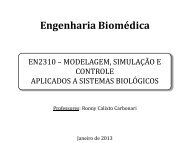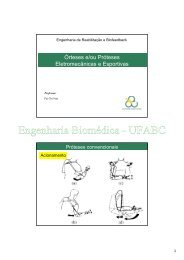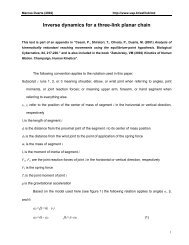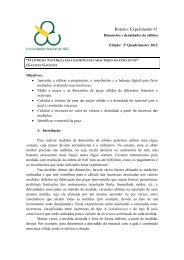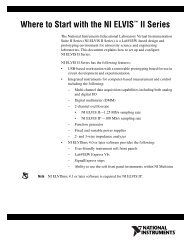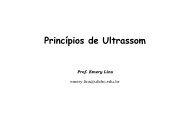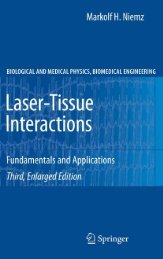Long-range correlations in human standing
Long-range correlations in human standing
Long-range correlations in human standing
- No tags were found...
You also want an ePaper? Increase the reach of your titles
YUMPU automatically turns print PDFs into web optimized ePapers that Google loves.
128 M. Duarte, V.M. Zatsiorsky / Physics Letters A 283 (2001) 124–128ied (unconstra<strong>in</strong>ed stand<strong>in</strong>g <strong>in</strong>stead of quiet stance).Contrary to the predictions for quiet stance, no <strong>in</strong>dicationof saturation of this anti-persistent behavior wasfound. We hypothesize that the observed saturationdur<strong>in</strong>g quiet stand<strong>in</strong>g reflects the biomechanical constra<strong>in</strong>tgiven by the base of support rather than a saturation<strong>in</strong> the neurophysiological processes underly<strong>in</strong>gthe anti-persistent behavior — when the biomechanicalconstra<strong>in</strong>t is reduced, no saturation is observed.In conclusion, we reported for the first time the existenceof long-<strong>range</strong> <strong>correlations</strong> <strong>in</strong> prolonged unconstra<strong>in</strong>edstand<strong>in</strong>g; a task similar to the natural stand<strong>in</strong>gof the daily life. An open issue is whether alterations <strong>in</strong>this fractal scal<strong>in</strong>g <strong>in</strong> <strong>human</strong> stand<strong>in</strong>g may be appliedto reveal pathophysiological disturbances as have beenobserved <strong>in</strong> heart-rate variability and stride-<strong>in</strong>tervalsdur<strong>in</strong>g walk<strong>in</strong>g [7,10].AcknowledgementsM.D. is thankful to FAPESP/Brazil for his postdoctoralscholarship.References[1] A series of experiments about balance disorders was conducted<strong>in</strong> the STS 95 mission of the NASA space shuttle, <strong>in</strong>clud<strong>in</strong>g astudy of balance <strong>in</strong> an elderly subject, the payload specialistJ.F. Glenn, 77 years old.[2] Due to body sway and <strong>in</strong>ertial forces, the COP position isdifferent from the center of gravity (COG) position, the latter<strong>in</strong>dicat<strong>in</strong>g the global position of the body.[3] J.J. Coll<strong>in</strong>s, C.J. De Luca, Exp. Bra<strong>in</strong> Res. 95 (1993) 308;J.J. Coll<strong>in</strong>s, C.J. De Luca, Phys. Rev. Lett. 73 (1994) 764;J.J. Coll<strong>in</strong>s, C.J. De Luca, Chaos 5 (1995) 57.[4] S. Thurner, C. Mittermaier, R. Hanel, K. Ehrenberger, Phys.Rev. E 62 (2000) 4018.[5] M. Duarte, V.M. Zatsiorsky, Motor Control 3 (1999) 12.[6] M. Duarte, V.M. Zatsiorsky, Neurosci. Lett. 283 (2000) 173.[7] J.M. Hausdorff, C.-K. Peng, Z. Lad<strong>in</strong>, J.Y. Wei, A.L. Goldberger,J. Appl. Physiol. 78 (1995) 349;J.M. Hausdorff, S.L. Mitchell, R. Firtion, C.-K. Peng, M.E.Cudkowicz, J.Y. Wei, A.L. Goldberger, J. Appl. Physiol. 82(1997) 262.[8] D.L. Gilden, T. Thornton, M.W. Mallon, Science 267 (1995)1837.[9] Y. Chen, M. D<strong>in</strong>g, J.A.S. Kelso, Phys. Rev. Lett. 79 (1997)4501.[10] C.-K. Peng, J. Mietus, J.M. Hausdorff, S. Havl<strong>in</strong>, H.E. Stanley,A.L. Goldberger, Phys. Rev. Lett. 70 (1993) 1343.[11] C.-K. Peng, S. Havl<strong>in</strong>, H.E. Stanley, A.L. Goldberger, Chaos 5(1995) 82.[12] C.-K. Peng, S.V. Buldyrev, S. Havl<strong>in</strong>, M. Simons, H.E.Stanley, A.L. Goldberger, Phys. Rev. E 49 (1994) 1685;C.-K. Peng, S.V. Buldyrev, A.L. Goldberger, S. Havl<strong>in</strong>, F.Sciort<strong>in</strong>o, M. Simons, H.E. Stanley, Nature 356 (1992) 168.[13] C.-K. Peng, S.V. Buldyrev, A.L. Goldberger, S. Havl<strong>in</strong>, F.Sciort<strong>in</strong>o, M. Simons, H.E. Stanley, Phys. Rev. E 47 (1993)3730.[14] J. Beran, Statistics for <strong>Long</strong>-Memory Processes, Chapman andHall, New York, 1994.[15] J. Feder, Fractals, Plenum Press, New York, 1988.[16] S. Havl<strong>in</strong>, R.B. Sel<strong>in</strong>ger, M. Schwartz, H.E. Stanley, A.Bunde, Phys. Rev. Lett. 13 (1988) 1438.[17] J. Theiler, S. Eubank, A. <strong>Long</strong>t<strong>in</strong>, B. Galdrikian, J.D. Farmer,Physica D 58 (1992) 77.[18] P. Bak, C. Tang, K. Wiesenfeld, Phys. Rev. Lett. 59 (1987) 381;M.B. Weissman, Rev. Mod. Phys. 60 (1988) 537.



